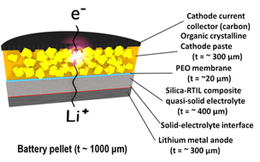有機材料を正極に用いた全固体リチウム二次電池
Rechargeable quasi-solid state lithium battery with organic crystalline cathode
2012年6月12日 Scientific Reports 2 : 453 doi: 10.1038/srep00453

レアメタルフリー且つ低コスト材料である有機分子をリチウム二次電池の正極に利用することは、技術者の長年の目標であった。しかし、液系電解質への有機分子の溶出に起因する致命的なサイクル特性劣化の問題が、実用化への大きな障害となっていた。過去数十年にわたって検討されてきた有機化合物をリチウム二次電池へ適用させるためには、新しい電池デバイス構造が必要である。今回我々は、有機結晶が固相状態であるにもかかわらず可逆的な充放電反応が進行する全固体電池を設計し、優れたサイクル特性と200 mAh/gを超える高容量の実現に成功した。さらなる研究によって、我々のデバイス設計がほかの多くのレドックス活性有機化合物に有効であることが確認された。このことは、かつてサイクル特性の不良を理由に採用されなかった何百という有機化合物が、全固体電池では再検討の価値があることを意味している。
- 東北大学 多元物質科学研究所
Utilization of metal-free low-cost high-capacity organic cathodes for lithium batteries has been a long-standing goal, but critical cyclability problems owing to dissolution of active materials into the electrolyte have been an inevitable obstacle. For practical utilisation of numerous cathode-active compounds proposed over the past decades, a novel battery construction strategy is required. We have designed a solid state cell that accommodates organic cathodic reactions in solid phase. The cell was successful at achieving high capacity exceeding 200 mAh/g with excellent cycleability. Further investigations confirmed that our strategy is effective for numerous other redox-active organic compounds. This implies hundreds of compounds dismissed before due to low cycleability would worth a re-visit under solid state design.

